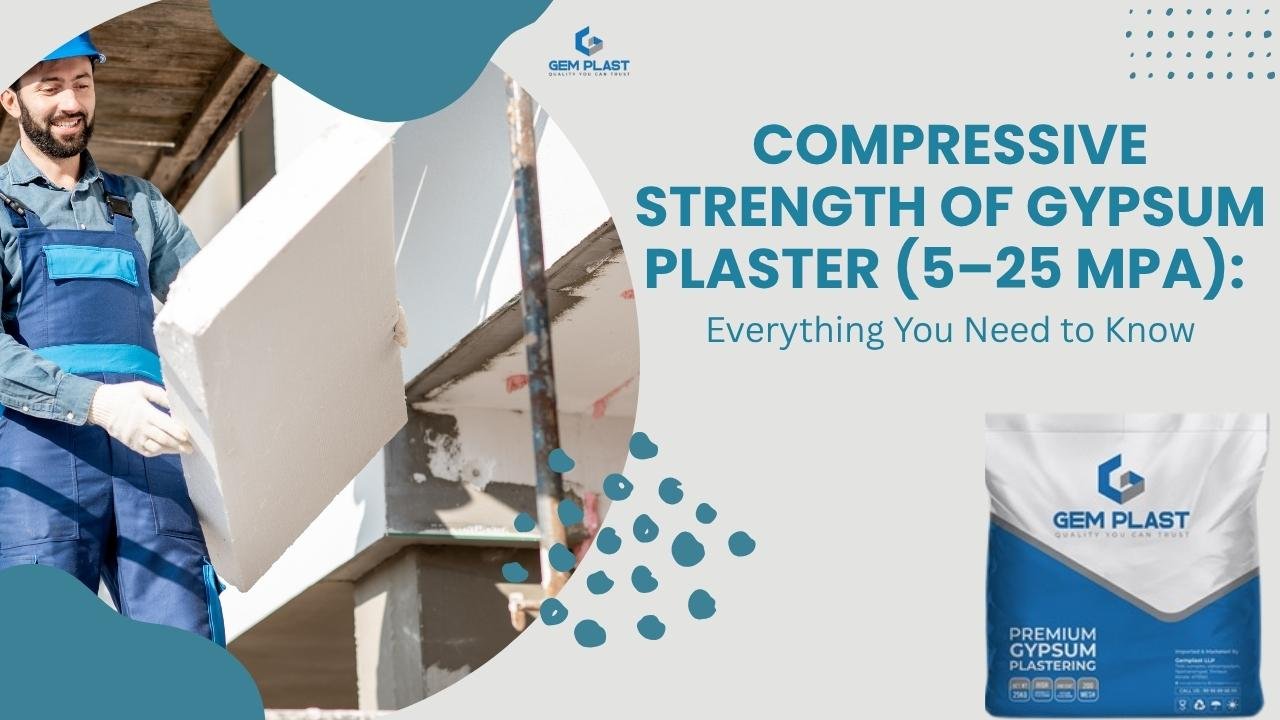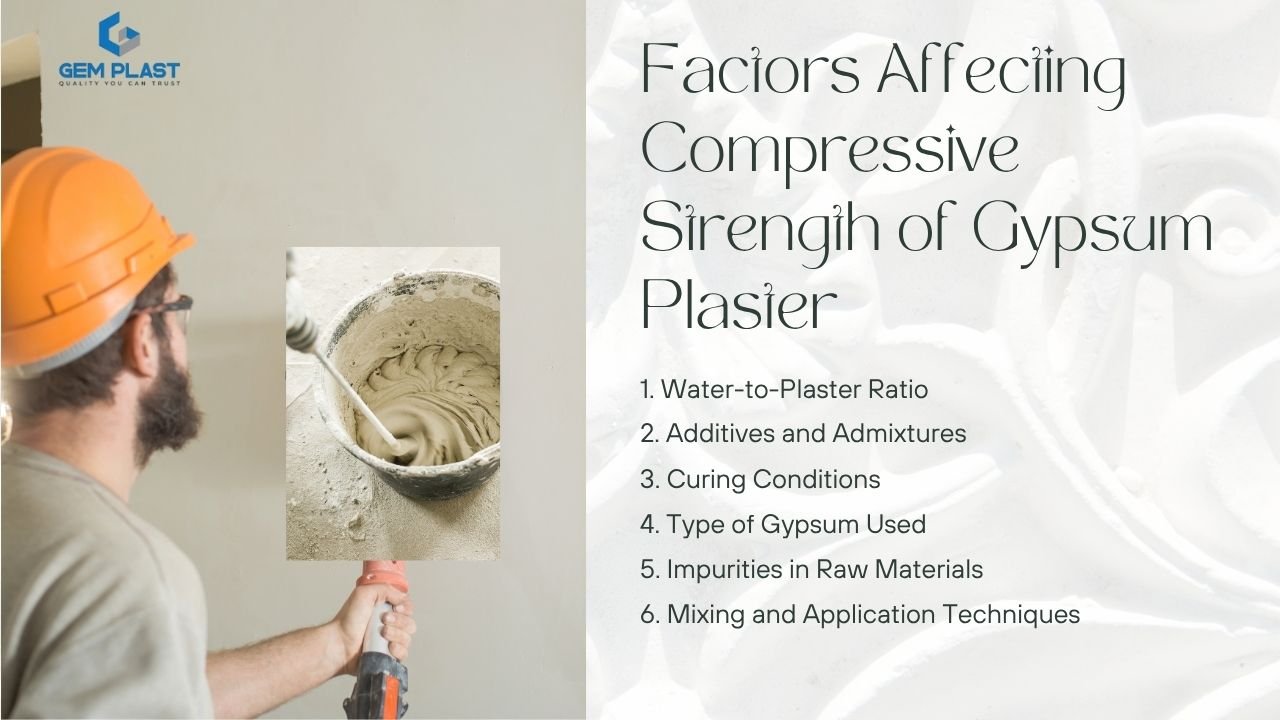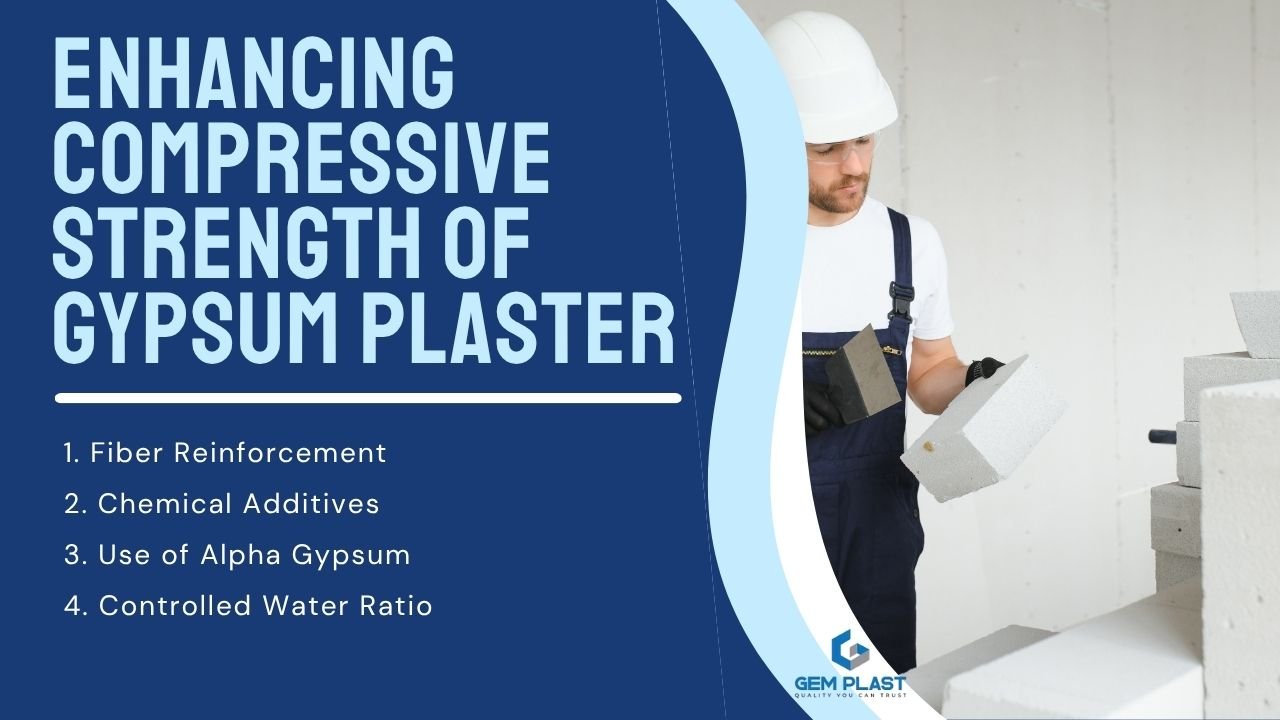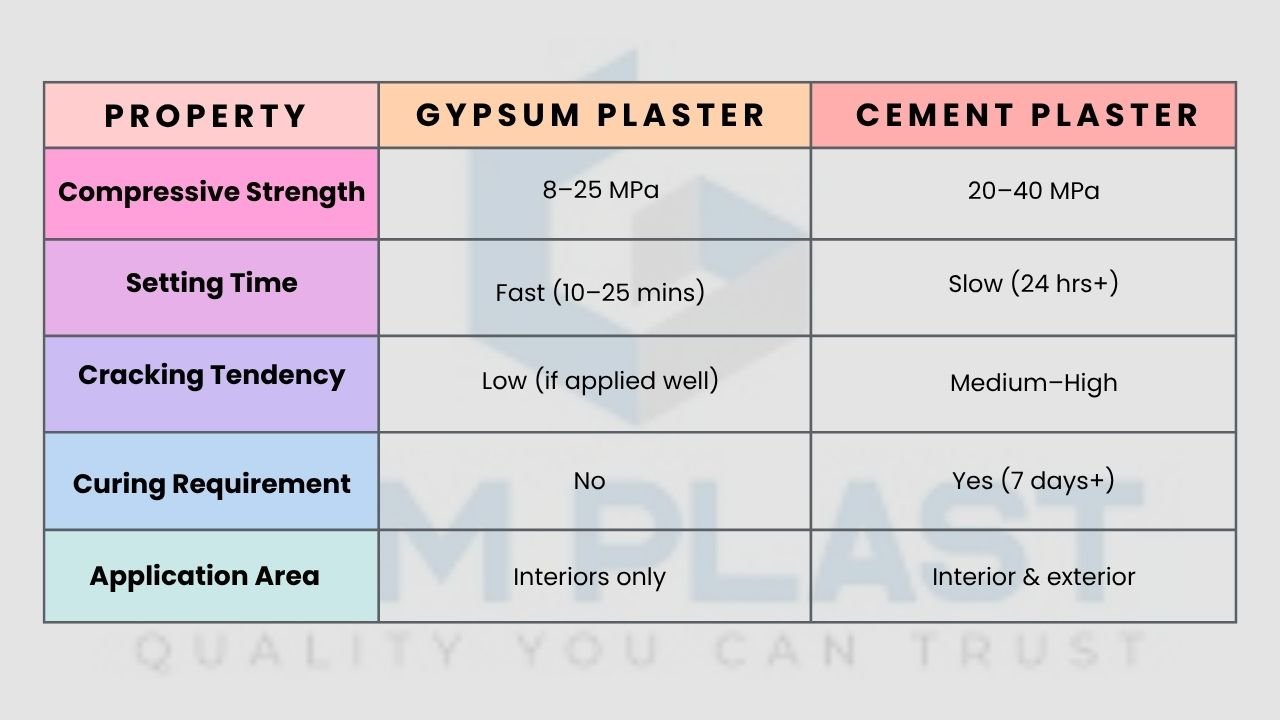Compressive Strength of Gypsum Plaster (5–25 MPa): Everything You Need to Know

In today’s world of construction, strength of the material is paramount. And when it comes to finishing interiors, Gypsum plaster is a standout because of gypsum plaster benefits like smooth, polished finish, fire-resistant, and its quick application. Beyond aesthetics and ease of use one key property determines its efficiency and its compressive strength. Compressive strength is the measure of how much weight a substance can withstand without breaking under pressure. For gypsum the strength directly affects its durability as well as its resistance to cracking and overall suitability to various applications such as ceiling and wall coatings to blocks that are prefabricated or decorative molds.
In this article we’ll look at the compressive strength of gypsum plaster in greater detail, what it is, as well as how it’s tested and what are the best values for various scenarios. No matter if you’re an engineer builder, architect or simply someone who is interested in building materials this guide will assist you in understanding how gypsum performs under pressure and how to make the most of it.
What Is Compressive Strength?
Compressive strength is the capacity of a material to resist axially directed force. It is the most compressive load a particular material can endure before it is destroyed and is divided by the size of its cross-section.
Mathematically:
For gypsum the compressive strength is an important measure of how the plaster performs when exposed to loads that are imposed for non-structural and structural uses.

Typical Compressive Strength of Gypsum Plaster
The strength of the compressive force of gypsum plaster may vary dramatically based on a variety of variables (which we’ll look at in the following section) However, the most common variation is:
For pure gypsum (without any additives): 5 – 15MPa
For gypsum-based mortars that contain aggregates or additives: 10 to 25 MPa
It is important to be aware that gypsum, even though it’s not normally used for load bearing walls or columns, its compressive strength is an important factor that determines the quality of a finishing material, in particular when it comes to the impact of or point load.
Factors Affecting Compressive Strength of Gypsum Plaster

Many factors influence the strength of the compressive force of Gypsum plaster.
1. Water-to-Plaster Ratio
The quantity of water mixed with gypsum directly impacts its microstructure. A lower ratio of water-to-plaster typically leads to a more dense matrix and a stronger compressive strength. However, too much water could affect the ability to work.
2. Additives and Admixtures
Incorporating materials such as lime, fibers, polymers or retarders may increase or decrease compressive strength. For instance adding the glass fiber or synthetic fiber could boost both compressive and flexural strength.
3. Curing Conditions
The conditions in which the gypsum is set temperature or humidity as well as time play an important part. Temperatures that are higher can speed up setting but they could also reduce the strength of the set when not properly controlled.
4. Type of Gypsum Used
There are many types of Gypsum (e.g. beta hemihydrate, alpha anhydrite). Alpha hemihydrate forms dense crystals, resulting in greater force than beta hemihydrate.
5. Impurities in Raw Materials
Impurities and salts could weaken the bond and adversely affect strength.
6. Mixing and Application Techniques
Incorrect mixing or application may result in voids or weak zones, which can reduce the capacity of compression.
Importance of Compressive Strength in Gypsum Applications
While gypsum isn’t employed in the primary load-bearing elements, it’s strength of compression can affect:
- Wall Integrity is resistant to scratches and compressive strains from fixtures, shelves as well as heavy-duty equipment.
- Durability: Strength increases endurance and wear resistance.
- Fire Safety: Denser, stronger plasters provide better fire resistance.
- Architectural Elements: Decorated panels and mouldings need adequate compressive strength in order to prevent wear and tear during installation and usage.
How to Test Compressive Strength of Gypsum Plaster
Gypsum’s compressive force is usually tested with standard cubes. This is a brief description of the procedure:
- Test Standard
Common standards ASTM C472 IS 2547 (Indian Standard) - Sample Preparation
Mix water and plaster according to normal proportions.
Pour the cubes into molds (usually 50mm in diameter x 50mm in size).
Allow the set to cure and cure for between 1 and 7 days, based on the testing. - Testing Equipment
- The universal test machine (UTM) is employed in order to compress load.
- Testing Procedure
- Place the cube of cured into the machine for testing.
Load is sprayed gradually.
Keep track of the load to which your specimen is unable to meet the load.
Calculate the strength of compressive force. - Result Interpretation
- A stronger compressive strength is a sign of more resistance to load.
Compare to benchmarks for the product (e.g. Interior finish vs. exterior cladding).
Enhancing Compressive Strength of Gypsum Plaster

To boost the strength of compressive forces for special applications, consider:
1. Fiber Reinforcement
The addition of glass, polypropylene or natural fibers can enhance both compressive and tensile properties.
2. Chemical Additives
Superplasticizers or pozzolanic materials such as silica fumes can increase the density of the mixture and decrease porosity.
3. Use of Alpha Gypsum
As we mentioned Alpha hemihydrate Gypsum is a great source of dense packing, which results in a higher compressive strength.
4. Controlled Water Ratio
Utilize the smallest amount of water to ensure workability. Insufficient water causes the formation of voids and weakens the structure.
Gypsum Plaster vs. Cement Plaster (Strength Comparison)

When it compared to gypsum plaster vs cement plaster, cement is stronger, but gypsum is favored for its speedier, less crack-prone and smoother work in the interior.
Real-World Applications and Compressive Strength Requirements
1. Interior Finishing
In the majority of commercial and residential structures, gypsum plaster can be employed for walls and ceilings. The strength of 10-15 MPa is usually adequate.
2. Moldings and Panels
Architectural components such as cornices medallions and partition boards require stronger durability (15-25 MPa) to ensure that they are not damaged during handling.
3. Gypsum Blocks
For walls that are not load bearing. The required compressive strength is usually 3 to 5 MPa, however blocks should be able to maintain their dimensional stability.
Environmental and Economic Considerations
Strengthening compressive strength doesn’t necessarily require a significant increase in cost or impact on the environment. For example:
- Industrial Gypsum (like FGD gypsum) recycles garbage while enhancing the quality.
- The optimization of water content can reduce the amount of material used.
- Additive efficiency permits minimal use to gain significant strength.
The balance between strength and sustainability is crucial in sustainable building design.
Common Myths About Gypsum Plaster and Strength
Myth: Gypsum plaster is weak and fragile.
Truth: When properly mixed and cured, Gypsum may have compressive strength similar to the moderate grades of concrete.
Myth: The idea that more water makes plaster more easy to put on and also better.
The truth: Water that is too much weakens the cement and decreases its strength.
Myth: That only cement-based products can be used on walls.
Truth: Gypsum plaster can be perfect for walls in interiors because of its quick setting and strength.
Conclusion
The strength of the compressive force of gypsum-based plasters plays a vital role in determining the potential for use in a variety of designs and construction applications. Although it is not commonly used to support structural loads the mechanical strength of the material particularly when compressed guarantees longevity, surface integrity along with long-term reliability.
Through understanding the elements that influence strength and implementing the best practices in mixing, curing, and choice of material Designers and builders can maximize the value of gypsum. As trends in construction shift towards more efficient, eco-friendly and more efficient products Gypsum stands out as a solid and a versatile choice – particularly when finish and strength quality are crucial.
FAQ
1. Is the strength of gypsum-plasterboard enough to be used for walls?
Yes. Gypsum plaster can be used in ceilings and walls, especially for non-load bearing applications. Although not as robust as cement plaster, and other gypsum plaster uses like its compressive power is adequate for moldings, finishes, as well as partitions.
2. What is the compressive strength of gypsum plaster measured?
The strength of compressive forces is evaluated with cube specimens, which are typically 50 mm x50 mm. The cubes are then dried, and then put through increasing loads using an Universal Testing Machine (UTM) till they break. This is the maximum force used in order to determine strength in MPa.
3. What is the strength of compression that is required for gypsum boards or blocks?
For gypsum blocks, the compressive strength minimum is typically around 3-4 MPa, depending on the use. For boards made of gypsum, the strength requirements vary based on the type of product and standard, but it is usually designed to withstand impact and surface load.
4. What kind of gypsum offers the strongest compressive strength?
Alpha Hydroxy gypsum (also known as high-strength gypsum) offers significantly more compressive force than beta hemihydrate because of its more dense and homogeneous crystalline structure.
